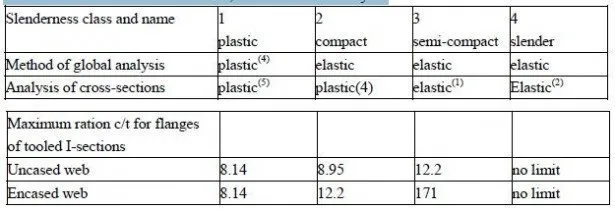The characteristic loadings to be used in worked examples are no given. They are taken from draft Eurocode 1.
The permanent loads (dead load) are the weights of the structure and its finishes. In composite members, the structural steel component is usually built first, so a distinction must be made between load resisted by the steel component only, and load applied to the member after the concrete has developed sufficient strength for composite action to be effective. The division of the dead load between these categories depends on the method of construction. Composite beams and slabs are classified as propped or unpropped. In propped construction, the steel member is supported at intervals along its length until the concrete has reached a certain proportion, usually three-quarters, of its design strength. The whole of the dead load is then assumed to be resisted by the composite member. Where no props are used, it is assumed in elastic analysis that the steel member alone resists its own weight and that of the formwork and the concrete slab. Other dead loads such as floor finishes and internal walls are added later, and so are assumed to be carried by the composite member. In ultimate-strength methods of analysis (Section 3.5.3) it can be assumed that the effect of the method of construction of the resistance of a member is negligible.
The principal vertical variable load in a building is a uniformly-distributed load on each floor.
For offices, Eurocode 1: Part 2.4 give for areas subject to overcrowding and access areas its
characteristic value as

is specified, acting on any area 50 mm square. These rather high loads are chosen to allow for a possible change of use of the building. A more typical loading qk for an office floor is 3.0kN/m2.
Where a member such as a column is carrying loads qk from n storeys (n>2), the total of these loads may be multiplied by a factor

The principal horizontal variable load for a building is wind. Wind loads are given in Eurocode 1: Part 2.7. They usually consist of pressure or suction on each external surface, though frictional drag may be significant on large flat areas. Wind loads rarely influence the design of composite beams, but can be important in framed structures no braced against side-sway (Section 5.4.2) and in all tall buildings.
Methods of calculation that consider distributed and point loads are sufficient for all types of direct action. Indirect actions such as differential changes of temperature and shrinkage of concrete can cause stresses and deflections in composite structures, but rarely influence the structural design of buildings. Their effects in composite bridge beams are explained in Volume 2.

